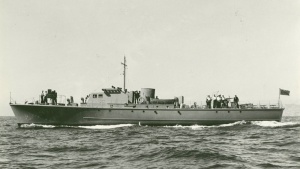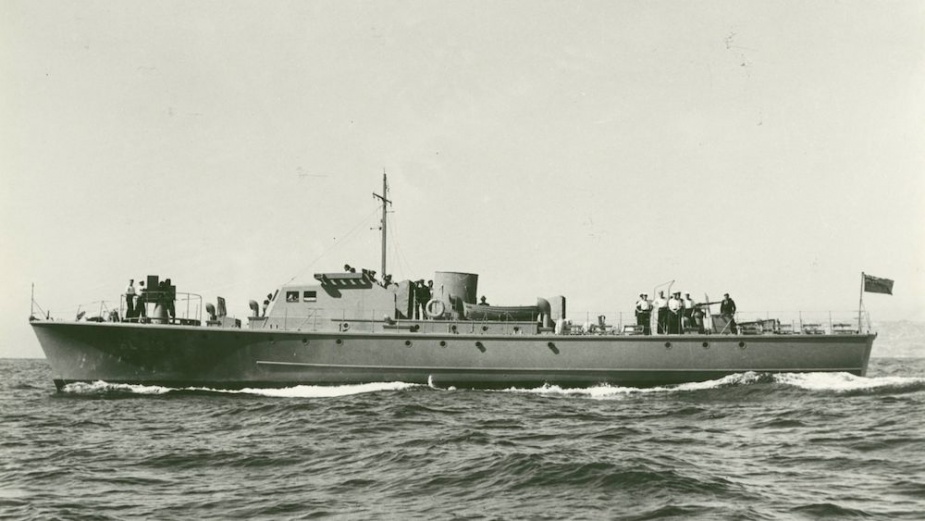ML 819
| Pennant |
ML819 |
|---|---|
| Builder |
Lars Halvorsen & Son, Sydney NSW |
| Commissioned |
10 May 1943 |
| Decommissioned |
13 December 1945 |
| Dimensions & Displacement | |
| Displacement | 75 tons |
| Length | 112 feet |
| Beam | 18 feet 4 inches |
| Draught | 4 feet 10 inches |
| Performance | |
| Speed | 20 knots |
| Complement | |
| Crew | 17-20 |
| Propulsion | |
| Machinery | Twin Hall Scott Defender petrol engines, 650 HP each, twin screws |
| Armament | |
| Guns |
|
| Other Armament | 16 x depth charges |
Fairmile motor launches were small, fast, highly manoeuvrable, lightly-armed ships designed in the United Kingdom. They were originally intended to be used for coastal anti-submarine and convoy protection duties but soon proved to be vessels capable of much broader operational tasking. This included servicing and supporting advancing troops, landing and recovering commandos and coast watchers behind enemy lines, rescuing civilians from enemy occupied territories, undertaking invasion escort duties and conducting hydrographic surveys in advance of landings. Rescuing downed airmen at sea, bombarding enemy strong holds and seeking and destroying enemy positions situated on inland waterways were also tasks routinely undertaken by these ships.
In April 1941 the Royal Australian Navy (RAN) recognised the need for a vessel which could be built locally and used in the coastal waters of Australia, New Guinea, the Dutch East Indies and their surrounding islands. On 5 January 1942 the war cabinet gave approval to construct Fairmiles in Australia and between November 1942 and April 1944, thirty five vessels were commissioned into RAN service.
ML 819 was a B type Fairmile, meaning it was larger, heavier and slightly slower then its unsuccessful predecessors the A types. It also enjoyed a greater radius of action. She was one of eleven Fairmile ships constructed by the Sydney based Lars Halvorsen & Sons Pty Ltd, and was completed in May 1943. She commissioned into service in the RAN at Sydney on 10 May 1943 under the command of Lieutenant Rollo AE Moore, RANVR. Sub Lieutenant Stephen H Hancock, RANR and Midshipman Robert G Gray, RANR, completed the wardroom complement.
Following her commissioning, ML 819 undertook a brief shakedown in waters off the NSW coast and Jervis Bay before sailing north to New Guinea calling at Brisbane, Gladstone, Bowen, Townsville en route. She arrived at Milne Bay, New Guinea, on 28 October 1943 remaining in the New Guinea area of operations for the next 14 months conducting a variety of escort duties and patrol work.
On 3 August 1944 ML 819 was assigned to Operation HUNTER along with seven other Fairmiles. The task given to this group was to conduct offensive operations designed to harass and destroy Japanese sea lines of communication and strafe Japanese land positions.
On 13 August, while taking part in Operation HUNTER, ML 819, in company with ML 430, arrived in an area where suspected enemy submarine activity had been reported. At 22:00 lookouts in ML 819 reported hearing the noise of heavy diesel engines, indicative of a submarine on the surface, and a short time later the silhouette of what appeared to be a large vessel was seen approximately one mile distant. ML 819 quickly radioed ML 430 to close her position to assist in an attack on what was believed to be an enemy submarine. ML 430 did not respond. When contact was later established with ML 430 another message was sent again ordering her to close ML 819. Although visibility was deteriorating and ML 430 was yet to be sighted the decision was made by Lieutenant Moore in ML 819 to press home an attack before the opportunity was lost.
At 23:10 ML 819, having increased speed to 18 knots, opened fire firing a long burst from each of her guns. Moments later ML 430 reported that she had been fired on and was ablaze. It was then that Lieutenant Moore made the sickening realisation that his vessel had fired upon ML 430 by mistake. Following a further search for the elusive enemy vessel, which proved fruitless, Moore manoeuvred 819 alongside 430 to rescue its crew who were actively engaged trying to put out a magazine fire. Once the men had been safely brought on board ML 819, Moore moved his vessel to a safe distance from the stricken vessel before again firing upon it to speed its end, however, this proved ineffective and the attempt was abandoned. Fortunately only two members of ML 430's crew were slightly wounded.
Following this ordeal ML 819 continued its search for the elusive enemy vessel and was rewarded when it again observed the silhouette of what was believed to be the submarine. In light of the previous unfortunate event a decision was made to positively identify the unknown vessel before an attack was made, however, it increased speed and soon disappeared. The vessel was later identified as a large submarine most likely from the Japanese I-class. Notwithstanding the disastrous and unexpected outcome of the patrol, Lieutenant Moore remained composed throughout the ordeal which resulted in the successful rescue of the crew of ML 430 and their safe return to base.
ML 819 remained in the New Guinea area of operations until the end of 1945 at which time she returned to Brisbane where she decommissioned on 13 December 1945.






